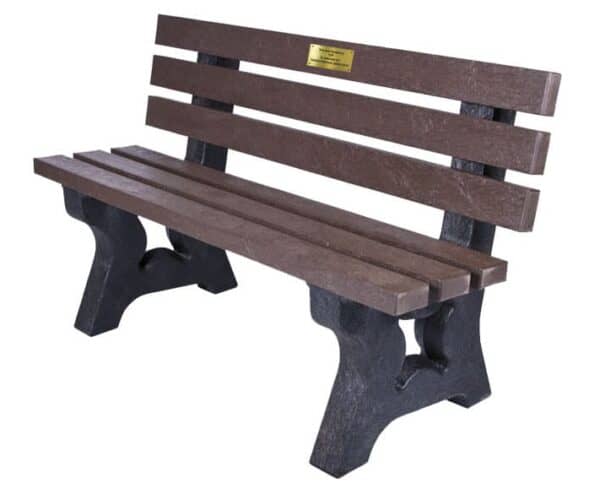Losing a loved one is never easy, and many of us seek meaningful ways to honour their memory. A memorial bench can be a beautiful tribute, providing a quiet place for reflection and remembrance. But if you are wanting to install one in a public place, it’s important to understand if planning permission is required.
Navigating local regulations and permissions can be daunting, so we’ve outlined a few things you might what to think about below. Wherever you’re considering placing your bench, whether it’s in a public park, a private garden, or a cemetery, knowing the rules will save time and ensure everything goes smoothly. Let’s explore what you need to know about planning permission for memorial benches.
Understanding Planning Permission
Planning permission is a crucial aspect to consider when installing a memorial bench. It ensures compliance with local regulations, avoiding potential legal issues.
What Is Planning Permission?
Planning permission is a formal consent from local authorities required for specific types of construction and alterations, including installing public amenities like memorial benches. This consent ensures that the proposed changes align with local development plans. Relevant authorities, such as parish, city or county councils, evaluate the impact on the environment, public access, and community infrastructure before granting permission.
Why Is Planning Permission Important for Memorial Benches?
Planning permission is important for memorial benches to ensure they meet local standards and regulations. Authorities consider factors like bench placement, design, and materials. For example, benches in public parks must not obstruct pathways or impede maintenance activities. In cemeteries, both aesthetics and harmony with existing structures might be prioritised. Seeking permission helps avoid conflicts with local communities who might have concerns about the placement and frequency of memorial benches in shared spaces. Additionally, gaining approval ensures the memorial bench remains a lasting tribute without any risk of future removal due to non-compliance issues.

Requirements for Installing a Memorial Bench
When considering a memorial bench, it’s essential to recognise specific requirements across varied locations.
Public vs. Private Land Considerations
Public and private lands come with distinct regulations for installing memorial benches. On public land, authorities typically require detailed applications that include placement, materials, and designs. Public spaces like parks and community areas focus on the bench’s impact on aesthetics and accessibility, as well as how many memorial benches are already located there. Private land permits vary, with fewer restrictions, but homeowner associations or landowners might have specific rules regarding installations to maintain property consistency.
Specific Regulations for Parks and Protected Areas
Parks and protected areas maintain strict guidelines for memorial benches to safeguard natural resources and public use. In parks, applications often demand environmental impact assessments to avoid disrupting local ecosystems. Applicants must also adhere to design standards that blend with the park’s character. Protected areas, such as nature reserves, enforce even stricter controls, requiring permissions that consider ecological preservation and conservation efforts. These areas might also have additional requirements, such as using eco-friendly materials (which is exactly what our memorial benches are made from) and restricting certain locations altogether to protect wildlife habitats.
Steps to Obtaining Planning Permission
Depending on your local authorities process, you may need to submit a planning application before you can install your bench. If so, here are some steps to consider when submitting an application.
Step 1: Consult your Local Authority
First, consult local authorities to understand any specific requirements for installing memorial benches. Each authority will have regulations specific to its location, so getting accurate information is crucial. You can visit your local authorities website and search for “memorial benches” to see if they have any existing information on their process – else you can try to find the details of their planning officers.
Step 2: Prepare and Submit Required Documents
Next, gather and prepare all required documents for submission. This typically includes design plans, site maps, environmental impact assessments, and consent forms. Detailed and precise documentation increases the chances of a smooth approval process. Ensure that design plans adhere to local aesthetic and safety standards. Submission usually occurs through the local authority’s planning portal or in person at their office.
Step 3: Await Approval
After submission, await the decision from the local authorities. Processing times vary depending on the authority, but generally range from several weeks to a few months. Check the status of the application periodically. If additional documentation is requested, be sure to respond promptly. Once approved, follow any stipulations provided in the planning permission document to ensure ongoing compliance.
Tips for a Successful Planning Permission Application
Navigating the planning permission process for a memorial bench becomes smoother with the right approach. Consider these tips before you submit your application;
Tip 1: Engage with the Community
Interacting with the community involved helps build support for the project. You might want to attend any community events such as a Parish Council meeting, where discussions allow residents to voice their opinions and contribute ideas. When support is strong or there are no objections, the planning authorities are more likely to view the application favourably.
Tip 2: Highlight the Benefits of the Memorial Bench
Emphasising the bench’s positive impact increases approval chances. Detail how the bench serves as a place for reflection and rest while enhancing the area’s aesthetic appeal. Communicating potential benefits such as improved social interactions and contributions to public amenities also strengthens the case. Support from local groups can further reinforce the bench’s value.

Potential problems.
While applying for planning permission for a memorial bench, several issues might arise. Here, we address common problems and how to deal with them.
Dealing With Rejections
Dealing With Rejections from planning authorities often revolves around understanding the reasons behind the denial. Analyse the feedback provided. Common reasons include non-compliance with local design standards, environmental impact concerns, or placement issues. If the rejection stems from design standards, ensure that the bench design aligns with the required aesthetics, materials, and accessibility guidelines. In cases of environmental impact concerns, assess how the bench interacts with the surrounding ecosystem and adjust your proposal accordingly. For placement issues, verify that the proposed location does not interfere with public pathways, utilities, or protected areas.
Modifying Your Proposal to Meet Guidelines
Modifying your proposal effectively involves adhering to specific guidelines outlined by the planning authorities. Start by seeing if your bench design can be altered to meet local aesthetic and material standards. Use eco-friendly materials if environmental impact was a concern. Incorporate accessibility features such as armrests and backrests to comply with universal design principles. When addressing placement issues, propose alternate locations that align better with public use and accessibility requirements. Additionally, engage with the local community to gather support and demonstrate broad-based backing for the proposed memorial bench, thereby enhancing the likelihood of approval.
Alternative Options Without Planning Permission
If seeking alternatives to a permanent memorial bench, consider those not requiring planning permission. These options provide flexibility and ease of implementation.
Placement on Private Property
Placing a memorial bench on private property streamlines the process. Homeowners can place benches in their gardens or yards without external approval and landowners (for example the National Trust) with have their own set of regulations they follow – start by contacting the landowner and asking how they handle memorial bench installations.
See If The Local Authority Can Provide And Install The Bench For You
Depending on where you want to put your memorial bench, some local authorities will manage the entire process for you. They might have a dedicated supplier of memorial benches that comply with all of their existing regulations and will oversee everything related to planning permission and installation on your behalf.
When you’re ready to move forward
Navigating the planning permission process for a memorial bench can seem daunting, but it ensures compliance with local regulations and respect for shared spaces. The first steps are determining whether you’ll need planning permission to install your memorial bench, so it’s best to contact the local authority or landowner in the first instance to see whether it’s possible to move forward with the installation of your bench. If planning permission is required, then hopefully you’ve found this post useful, and it helps you understand the process a bit more. If it’s not possible to get planning permission, seeking out a suitable privately owned location might be a viable alternative.









